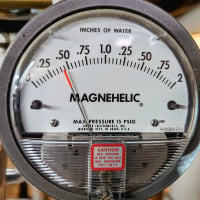Vent-Rite No. 1 Tongue Orientation

Comments
-
Yes, it does -- the tongue is supposed to let any moisture that collects move back into the radiator and drip inside.Br. Jamie, osb
Building superintendent/caretaker, 7200 sq. ft. historic house museum with dependencies in New England0 -
@Jamie Hall Can you give me any suggestions on how to keep the tongue from rotating? Thanks0
-
Once it's in place it should stay put... it might flop up and down, but it shouldn't be free to rotate... I think.Br. Jamie, osb
Building superintendent/caretaker, 7200 sq. ft. historic house museum with dependencies in New England0 -
-
-
The tongues on the vent-rites aren’t affixed, and often move. I would simply pull it out. I’d rather know there isn’t anything obstructing the condensate then be guessing. The tongue on the Hoffman is affixed so this isn’t an issue, but again, with the vent-rite it isn’t.0
-
My experience with those vents is the gasket wears out from the small wheel at the bottom and water starts to leak out there. If the condensate now can't even drain out the way it's supposed to, they might fail sooner.0
-
On some of the radiators, I could feel/hear the tongue scraping on the threads as I rotated it in. I tried to rotate as gently as I could to keep it from catching.0
-
I'm not concerned with the tongues rotating once in. I'm worried that they are catching and being rotated as I screw the vent in.0
-
Thanks everyone for your help.
I think I figured out what was going on. There is a little slot in the back of the vent that the tongue fits into that keeps it from rotating. As long as the tongue is fitted in that slot, it can't rotate (much). When I removed the old vents, the tongue was getting caught on corrosion/threads and the vent kept moving backwards out of the hole, and the tongue was pulled out of the slot. Then the vent kept spinning as I unscrewed it but the tongue stayed where it was. I think that as long as the tongue is securely fitted in the slot and the vent is being screwed in and moving "forwards" the tongue will stay in the slot and not rotate.1 -
Why do the float type vents (Vent-Rite, Hoffman) include this tongue while the bimetallic vents (Gorton, et al) do not?Jamie Hall said:Yes, it does -- the tongue is supposed to let any moisture that collects move back into the radiator and drip inside.
1 -
I've wondered the same thing.Marc_18 said:
Why do the float type vents (Vent-Rite, Hoffman) include this tongue while the bimetallic vents (Gorton, et al) do not?Jamie Hall said:Yes, it does -- the tongue is supposed to let any moisture that collects move back into the radiator and drip inside.
Single pipe 392sqft system with an EG-40 rated for 325sqft and it's silent and balanced at all times.
0 -
I bought a new one and it didn't seem to work. I think the tongue keeps moving out of place each time.
Do you think it would be crazy to try using it without the tongue? In other words; removing the tongue?0 -
isn't the tongue just there to encourage any water that gets in it to run out, it really doesn't have anything to do with the function of the vent.
0 -
Sounds painful. 🤪
0 -
Try bending the tongue up slightly, so it doesn't catch on the threads in the hole.
All Steamed Up, Inc.
Towson, MD, USA
Steam, Vapor & Hot-Water Heating Specialists
Oil & Gas Burner Service
Consulting0 -
The float type vents have a tongue to separate condensate removal from steam entry. Since they have much less clearance space in them than the Gorton vents, fluid cohesion and surface tension tends to hold the water in the vent.
Gorton and other bi-metal element vents have a large clear area where condensate's greater collected weight and lack of tight clearances cause it to drop and drain from the vent.
The feature is mentioned in the product's patent.
1 -
I took off the (recent purchased) Vent-Rite air-vent.
I set the dial to 5.
I carefully screwed it back in place on the radiator.
The next day, it maintained a 68 deg temperature.
I prefer a 70 deg temperature for this room, so I raised the dial to 6.
The next day, it maintained a 66 deg temperature.
It’s supposed to get warmer.
What would cause it to get colder?
(My guess is its because of the stupid tongue moving out of place.)0 -
What did the weather outside do and how did it effect boiler run times?
You're using an adjustable vent not a TRV.
Single pipe 392sqft system with an EG-40 rated for 325sqft and it's silent and balanced at all times.
0
Categories
- All Categories
- 87.2K THE MAIN WALL
- 3.2K A-C, Heat Pumps & Refrigeration
- 60 Biomass
- 427 Carbon Monoxide Awareness
- 119 Chimneys & Flues
- 2.1K Domestic Hot Water
- 5.8K Gas Heating
- 115 Geothermal
- 165 Indoor-Air Quality
- 3.7K Oil Heating
- 75 Pipe Deterioration
- 1K Plumbing
- 6.4K Radiant Heating
- 394 Solar
- 15.6K Strictly Steam
- 3.4K Thermostats and Controls
- 56 Water Quality
- 51 Industry Classes
- 49 Job Opportunities
- 18 Recall Announcements


